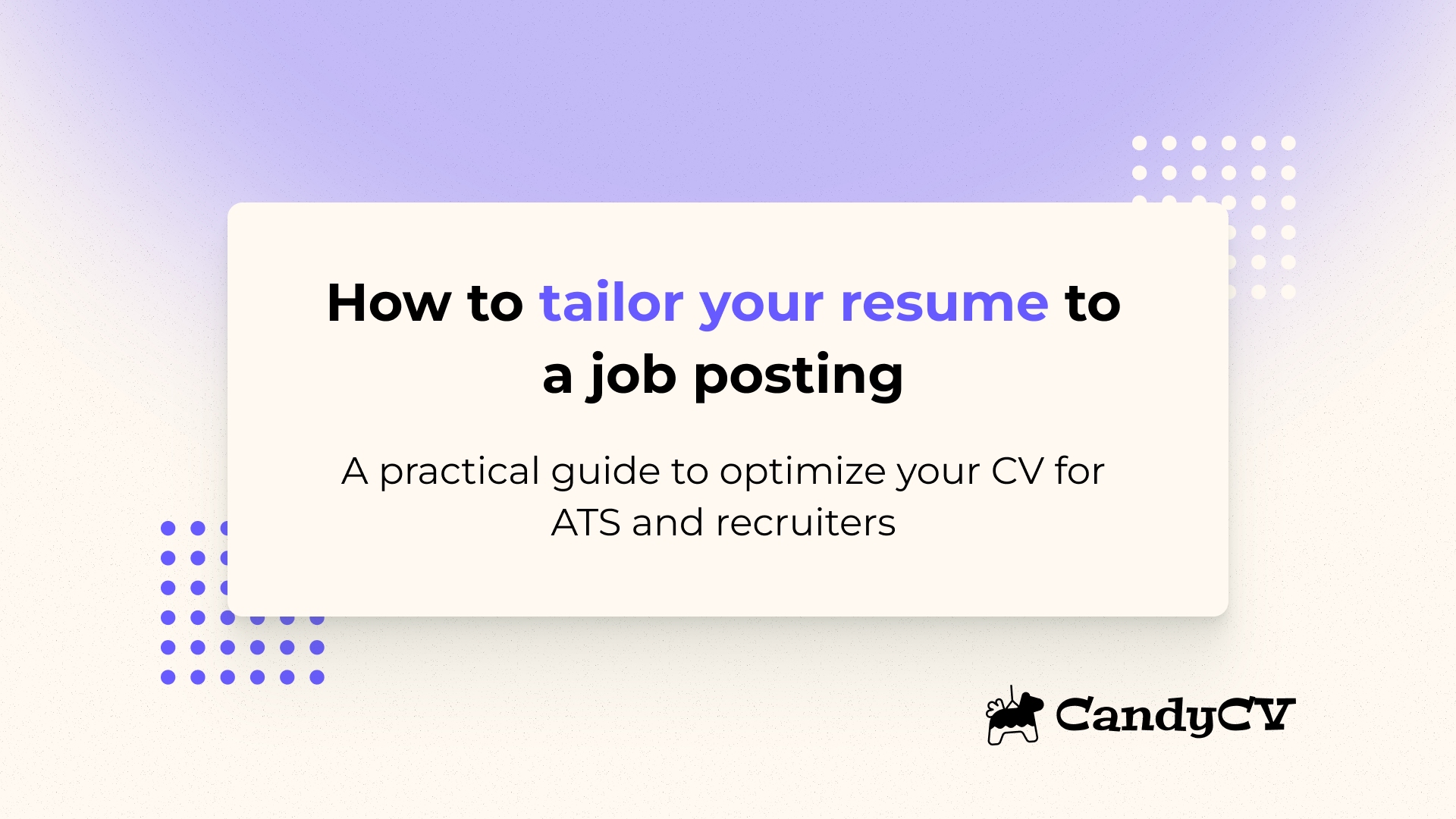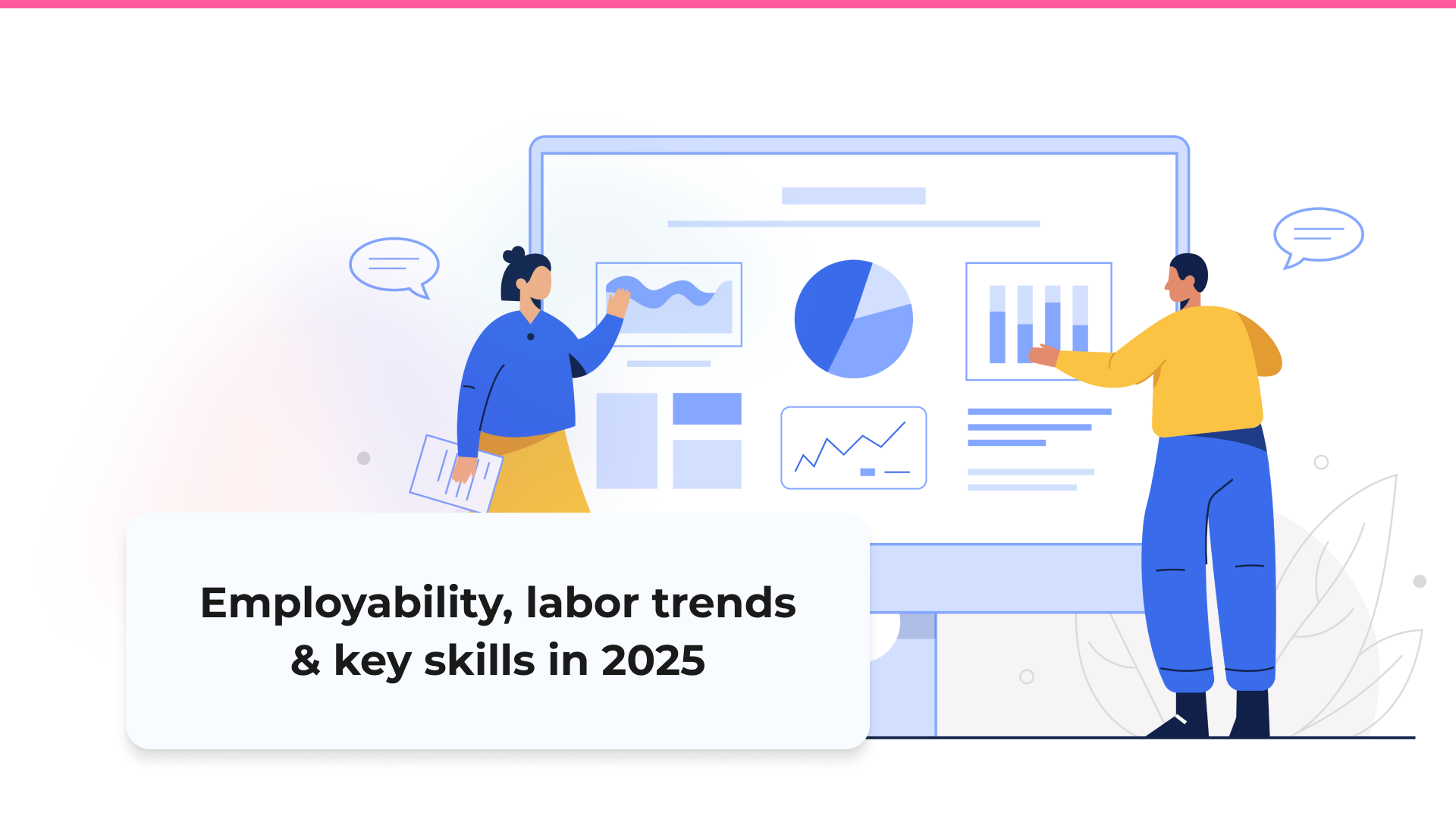
Labor Trends in 2025: in-demand sectors and skills with the most job opportunities
Companies around the world are redefining their hiring processes, priorities, and expectations for candidates. Artificial intelligence, automation, sustainability, and shifts in workplace culture are changing how companies recruit, what profiles they value, and how hiring decisions get made.
We’ve gathered the most relevant stats from recent studies on the global job market to create a practical guide with recommendations for job seekers in 2025. People like you who face a competitive, fast-changing, and often frustrating labor market.
This report covers:
- The Employment Paradox in 2025: why are there more job openings but unemployment isn’t dropping?
- The most in-demand skills and competencies in today’s workforce.
- The fastest-growing sectors and job opportunities.
- Global recruitment trends in 2025 and how to get ready.
- Practical tips to boost your chances of landing a job.
1. The Employment Paradox in 2025
In countries like Spain, Mexico, Colombia, Argentina, and the United States, macroeconomic data reveals a phenomenon known as the employment paradox: more and more job openings remain unfilled while people remain unemployed. The International Labour Organization has documented this global employment recovery after the pandemic, but talent consulting firms like ManpowerGroup note that rising job vacancies rising job vacancies don’t directly translate into lower unemployment.
The issue isn’t the number of jobs, but rather the mismatch between the skills employers need and those job seekers have. Companies are creating roles that require new competencies most applicants don’t yet possess. This hits hardest in dynamic sectors like tech, logistics, sustainability, and healthcare, where specific training and adaptability are key. That’s why employers say it’s getting harder and harder to hire talent despite the growing number of candidates. The World Economic Forum has consistently highlighted this skills gap in its Future of Jobs reports.
Several underlying reasons drive this mismatch:
- Gap between education and labor demand: university and training programs often don’t update fast enough to keep up with industry needs.
- Relentless technological acceleration: new technologies emerge so quickly that skills become obsolete faster than the workforce can adapt or retrain.
- Insufficient investment in large-scale reskilling and upskilling: while many companies recognize the need to train employees, investment in massive reskilling (learning new roles) and upskilling (enhancing current skills) programs still falls short.
1.1. Essential skills and competencies for 2025
More and more companies are prioritizing what you can do over where you learned it. For example, a 2023 report from the Capgemini Research Institute highlights that over half of surveyed organizations are making the shift to skills-based hiring models.
Meanwhile, the Coursera Job Skills Report 2025 highlights the top job skills for professional success, based on analysis of millions of learners. The report groups skills into four main areas:
- Talent Development Skills: with key skills in short supply and urgent need for reskilling and upskilling, companies increasingly seek people who can train others and help teams adopt new competencies. This includes mentoring, coaching, instructional design, and knowledge management.
- Tech Skills: covering Software Architecture, React, Systems Design, Linux, Systems Security, and PostgreSQL. These are the foundation for innovation and maintaining robust digital infrastructure.
- Data Science Skills: including Data Modeling, Data Visualization, and proficiency with tools like Tableau and Power BI (essential for data-driven decision-making).
- Business Skills: crucial for acquiring and managing clients in today’s channels, such as:
- E-Commerce: buying and selling via digital platforms.
- Media Strategy & Planning: delivering the right content to the right audience.
- Search Engine Optimization (SEO): boosting website rankings in search engines.
- Customer Success Management: creating long-term value for clients.
Industry leaders also emphasize upskilling in areas like data ethics, cybersecurity, and AI-driven tools.
2. Fastest-growing sectors and job opportunities in 2025
If you’re just starting out or feel stuck in your job search, it might be time to look at other sectors. These are the sectors generating the most jobs across Europe, Latin America, and the U.S., and how you can pivot toward them:
| Sector | Why it’s growing | What you can do |
| Tech & Data | Digital transformation across all industries. Rise of new technologies. | Take courses on Coursera, Google, OpenBootcamp, Microsoft AI. Specialize in programming, data analysis or cybersecurity. |
| Health & Biotechnology | Aging populations and expanding healthcare services. Innovation in treatments and pharmaceuticals. High employability. | Get technical training in pharmacy, geriatrics, caregiving, bioinformatics or clinical research. |
| Renewable Energy | Global investment in green transition. Institutional support and subsidies. Growing demand for clean energy. | Train in solar, wind, energy efficiency and sustainable project management. |
| Logistics & E-Commerce | Boom in online shopping and increasingly complex supply chains. Need for optimization and automation. | Study logistics, digital marketing, ERP management, warehouse management, process automation. |
| Sustainable Construction | Shortage of skilled workers in energy-efficient retrofitting. Low competition and good pay. | Vocational training or certifications in green construction trades, energy audits, BIM. |
| Tourism & Services | Strong post-pandemic recovery in LATAM and southern Europe. Demand for skilled, adaptable staff. | Improve language skills, customer service, and digital tools for hospitality management. Develop soft skills. |
Global talent consultancies like Randstad Research and sector reports from Hays consistently highlight these as the fastest-growing and most in-demand sectors.
2.1. Sustainability as a driver of “green” jobs
The green economy is becoming a major driver of job creation. In Europe, the circular economy is projected to represent a significant share of jobs by 2030, a trend supported by Eurostat reports on green jobs and the circular economy. In the United States, green jobs are at the core of public policies, while in Latin America, countries like Chile, Colombia, and Mexico are promoting green employment in clean energy, recycling, and energy efficiency, as highlighted by the Inter-American Development Bank.
Additionally, companies increasingly value employees who share environmental and social values. This not only boosts their employer brand but also meets ESG regulations and enhances global competitiveness. This focus on ESG (Environmental, Social, and Governance) criteria is a key trend emphasized by consultancies like PwC in their analyses of sustainability’s role in corporate environments and talent attraction.
If you have experience or interest in sustainability, energy efficiency, circular design, or renewable energy, now is your moment. Integrating sustainability into your professional profile can open many more doors than you might expect.
3. Global Recruitment Trends: navigating the hiring process
Understanding how selection processes work today is crucial to make the most of the tools available during your job search. Let’s break it down:
3.1. Your resume gets filtered by an ATS (Applicant Tracking System)
ATS are the first filter in most companies’ hiring processes nowadays, except in very small businesses. These systems extract information from your resume, automatically create your candidate profile in their database, and filter out those who don’t meet certain criteria.
Practical tips to optimize your resume for ATS:
- Use keywords: include exact or related keywords from the job description.
- Avoid complex formats: steer clear of tables, columns, or heavy graphic designs that ATS can’t read.
- File format: download your resume as a PDF with embedded text, not as an image.
- Reverse-chronological structure: list your work experience from most recent to oldest. Here’s why reverse-chronological format is usually best.
- Use specialized tools: try platforms designed to create ATS-friendly resumes, like CandyCV.
Check out this guide on how ATS works and how it affects your resume and job search.
3.2. Artificial Intelligence is already part of your hiring process
AI is present in more and more stages of recruitment: from ATS systems to automated video interviews. This trend is well-established in large U.S. corporations as well as medium-sized European and Latin American companies. A 2023 Gartner report on HR technology trends highlights this growing adoption of AI in recruitment.
But companies also expect you to know how to work with AI, not as a programmer, but as a professional who uses the right technology to get the job done more efficiently. Microsoft’s and LinkedIn’s “Work Trend Index Annual Report 2023” shows that most business leaders expect new hires to have AI skills, considering them as essential as basic digital skills.
3.3. Recruiters find you even if you haven’t applied (if you do it right)
Proactive recruiting is on the rise: according to LinkedIn Talent Solutions’ ““Global Talent Trends” report” report, recruiters search directly on LinkedIn and databases. If your LinkedIn profile isn’t optimized or your resume isn’t accessible online, you’ll miss out on tons of opportunities. One effective way to get found without applying is to turn your resume into a personal website. Tools like CandyCV let you do this for free. That way, you can share your resume link on social media or your email signature, and recruiters can find you directly on search engines like Google.
Key actions to boost your LinkedIn visibility:
- Update your headline: make it descriptive with your specialty or the kind of role you’re looking for (e.g., “Software Engineer | AI Specialist | Open to New Opportunities”).
- Show availability: turn on “Open to Work” discreetly so recruiters know you’re open to offers (no need to add a frame to your photo).
- Publish valuable content: share articles, opinions, or useful reflections that show your expertise, knowledge, and areas of impact.
Create an online version of your resume with CandyCV so recruiters and hiring managers can find you online and reach out proactively, opening doors to hidden opportunities.
4. What companies are looking for (and what you should look for too)
Today, the “match” isn’t just about meeting technical requirements. Companies want people who share their way of working, values, and vision.
Employers seek candidates with:
- Curiosity and a growth mindset: in a rapidly changing environment, adaptability and a willingness to learn new skills are crucial.
- Digital and strategic thinking: professionals who understand technology’s impact and can apply it to solve problems and create value.
- Commitment to values: alignment with principles like sustainability, diversity, inclusion, and innovation.
- Autonomy and initiative: proactive professionals who can take charge and make an impact from day one.
Deloitte’s Deloitte’s Global Human Capital Trends report report highlights the growing importance of purpose and culture in employability and talent attraction.
And as a candidate, you should look for companies that:
- Support your professional growth: offering opportunities for advancement, training, and challenging projects.
- Promote well-being and flexibility: a work environment that fosters work-life balance, with flexible hours or work models.
- Align with your values: a culture that resonates with your personal and professional principles, promoting an ethical and positive environment.
Global surveys from platforms like Gallup show that well-being and value alignment are key factors in employee satisfaction and retention.
Cultural fit doesn’t just help you get the job, it helps you stay, grow, and enjoy it.
5. Key recommendations for your job search in 2025
This is a time of deep transformation in employment, but also a real opportunity for those who choose to adapt and move forward. If you’re job hunting now, here are our top tips based on the latest trends and expectations:
5.1. Train in the most in-demand new skills
Invest in practical, ongoing learning. Prioritize skills the market demands: AI, digital tools, sustainability, advanced technical skills, and of course, soft skills. Explore online courses, certifications, or bootcamps that let you acquire these competencies quickly.
5.2. Optimize your resume for ATS and people
Make every word on your resume count. Tailor your CV for each job, using a clean, clear format and including relevant keywords from the job description. Remember, while ATS are the first filter, your resume also needs to be appealing and easy to read for human eyes. Tools like CandyCV can be your allies here.
5.3. Strengthen your professional digital presence
Your personal and digital brand is a vital extension of your candidacy. Strategically update your LinkedIn profile, consider having an online version of your resume, actively participate in online communities in your field, and if possible, publish professional content that showcases your expertise. Recruiters will look for you, and you want to be found.
5.4. Practice new types of interviews
Prepare thoroughly for both traditional human interviews and new automated formats (pre-recorded video interviews, AI assessments, etc.). Learn how to structure your answers with concrete examples, and practice on camera to feel confident and project assurance.
5.5. Network with purpose
Many job opportunities are never publicly posted. Connect with professionals in sectors or companies you’re interested in. When reaching out, ask for advice and insights about the industry, not just job openings. Genuine, strategic networking can open unexpected doors and build valuable professional relationships.
Conclusion: your future job is in your hands
The recruitment landscape in 2025 is undoubtedly a constantly evolving ecosystem. The employment paradox shows us that the issue isn’t a shortage of jobs, but a profound transformation in the skills and profiles in demand. Companies today are looking for adaptable people, digitally savvy professionals, and those aligned with values like sustainability and innovation. Artificial intelligence and automation are no longer future trends but present realities at every stage of the hiring process: from ATS filtering to recruiters’ expectations of your AI skills.
Investing in continuous learning, strengthening your digital presence, and tailoring your profile to fast-growing sectors can make all the difference. It’s not just about landing a job but finding a place where you can grow, contribute, and build a meaningful career. Your proactivity and openness to change are the keys to navigating and thriving in the future of work.
Frequently Asked Questions (FAQs)
What is the Employment Paradox and how does it affect me?
The “Employment Paradox” refers to the current situation where there are many unfilled job openings alongside a significant number of unemployed people. It affects you because the problem isn’t a lack of jobs but a mismatch between the skills companies need and the skills candidates have. To overcome it, focus on acquiring the skills most in demand in the market.
Which sectors offer the most job opportunities in 2025?
Technology, healthcare, renewable energy, logistics, sustainable construction, and tourism are the most dynamic sectors according to reports by Randstad and Hays.
What are the most important skills to get a job in 2025?
The most in-demand skills in 2025 include both technical skills (such as Software Architecture, Systems Security, Data Modeling and Visualization, SEO, E-commerce, AI management) and talent development plus soft skills (curiosity, continuous learning, digital mindset, autonomy, data ethics, and critical thinking). Adaptability and “learning how to learn” are essential.
How can I optimize my resume for Applicant Tracking Systems (ATS)?
To optimize your resume for ATS, it’s crucial to use relevant keywords from the job description, avoid complex formats (tables, hard-to-read columns), save the file as a text-based PDF, and maintain a reverse-chronological structure. Using specialized tools like CandyCV can help ensure your resume is both ATS-friendly and readable.
What tools can I use to improve my resume?
You can use specialized platforms like CandyCV. This tool stands out for its real compatibility with ATS, as its templates are designed to ensure optimal reading and data extraction by these systems. It allows real-time editing, making resume creation and modification easy. Plus, it offers content guides, keyword optimization tips, and a transparent, ethical business model. You can even turn your resume into your own website so companies can proactively find you online.
How can I get noticed by recruiters without applying to job postings?
Proactive recruiting is on the rise, with many recruiters searching directly on platforms like LinkedIn or online resume versions. Keeping your LinkedIn profile updated and optimized, showing your availability, and having an online version of your resume (discoverable on Google) will significantly boost your chances of being contacted for unposted opportunities. CandyCV lets you create a free online resume.
What role does Artificial Intelligence play in today’s recruitment?
Artificial Intelligence is integrated into almost every phase of recruitment, from the initial CV filtering by ATS to automated video interviews and candidate pre-selection. Furthermore, companies expect candidates not only to understand AI but also to use AI-powered tools to improve their work efficiency.
We're two product builders who care about quality, taste and doing things right. We want you to get that job you want, plain and simple. That's why we are building CandyCV to help you create a great resume and land a job for free. If you give us a try (and feedback!), we'll be forever grateful 😊
Alba Hornero
Co-founder and Product Builder
As CandyCV’s co-founder and a former product lead in HR tech, I’ve built ATS tools, optimized hiring processes, and interviewed hundreds of recruiters. I personally write every post with the intention to provide real, high-impact job search advice that truly helps you land your next role.
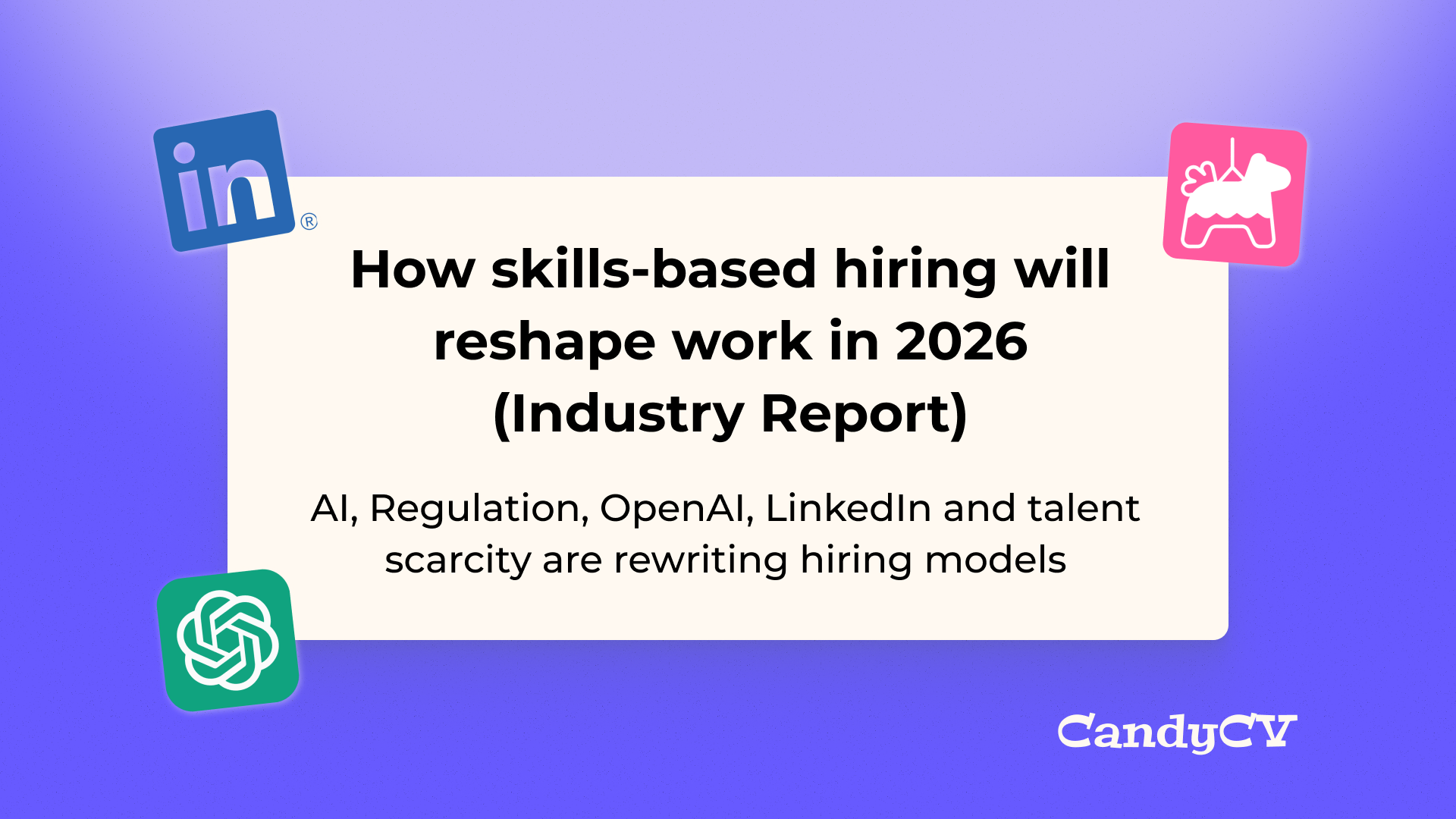
The skills-based hiring report: what it is and how it will reshape work in 2026
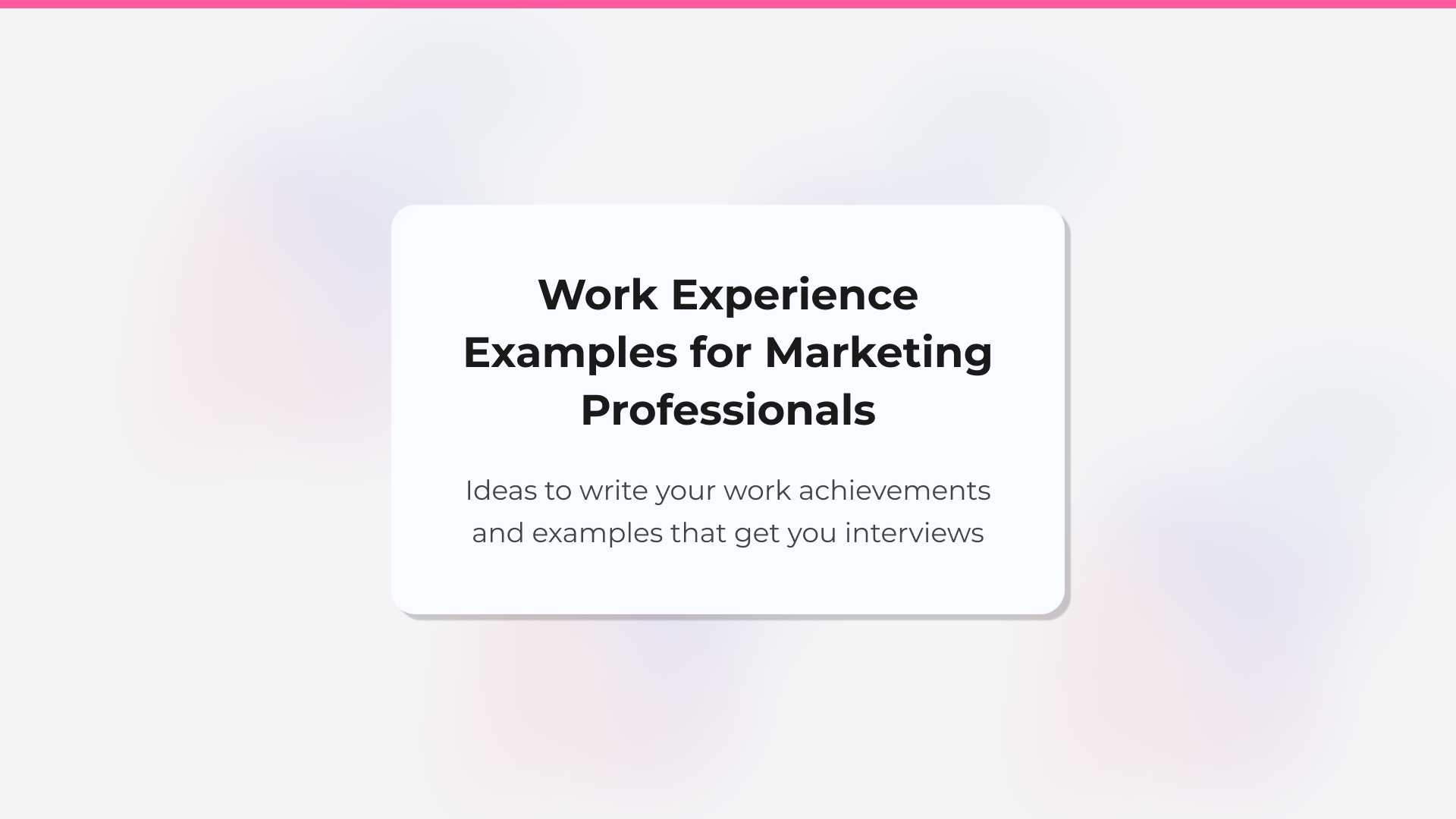
Examples of how to describe your work experience in a Digital Marketing resume

How to list Education and Certifications on your resume (with examples)
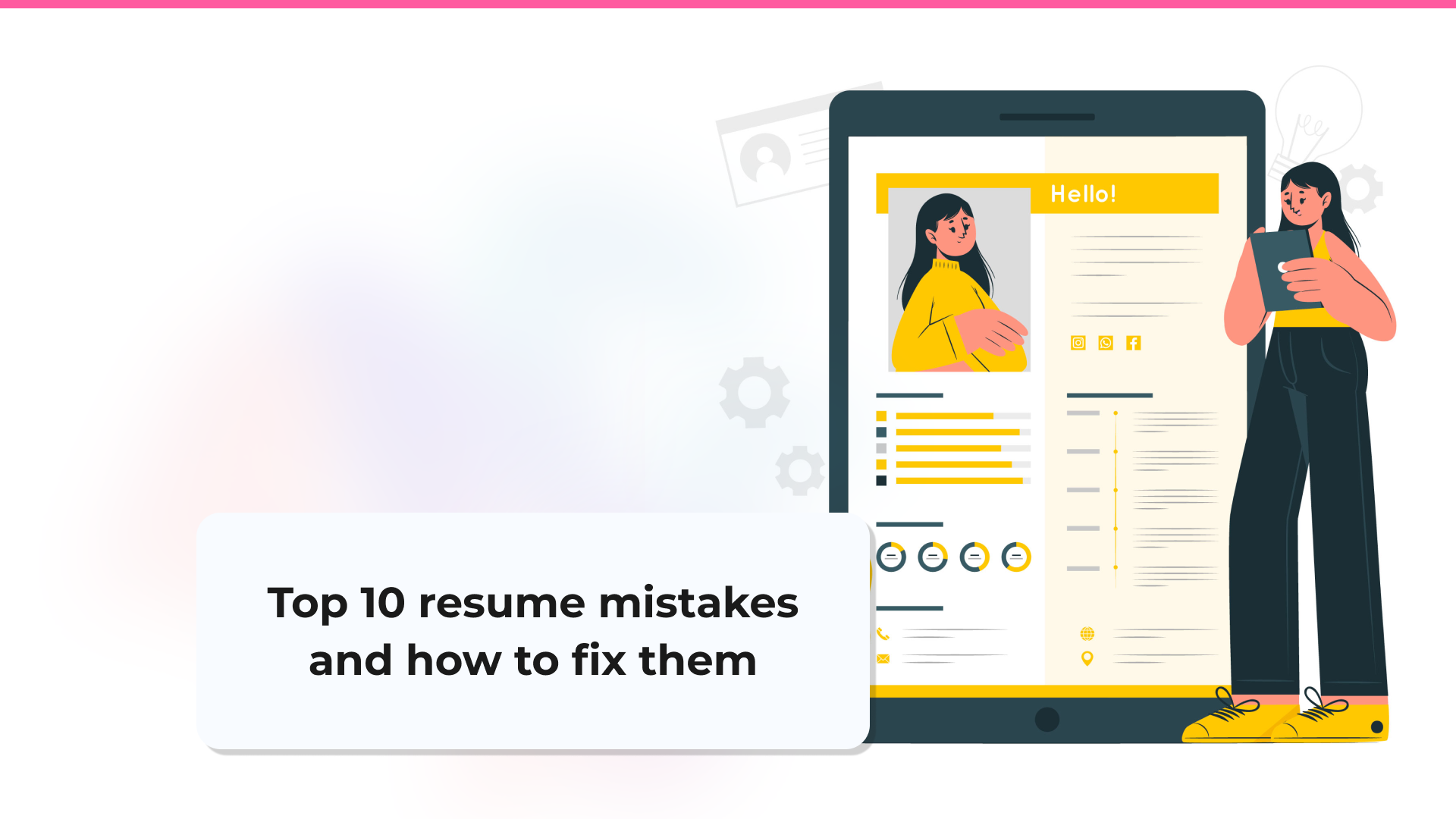
Top 10 resume mistakes to avoid in 2025 and how to fix them
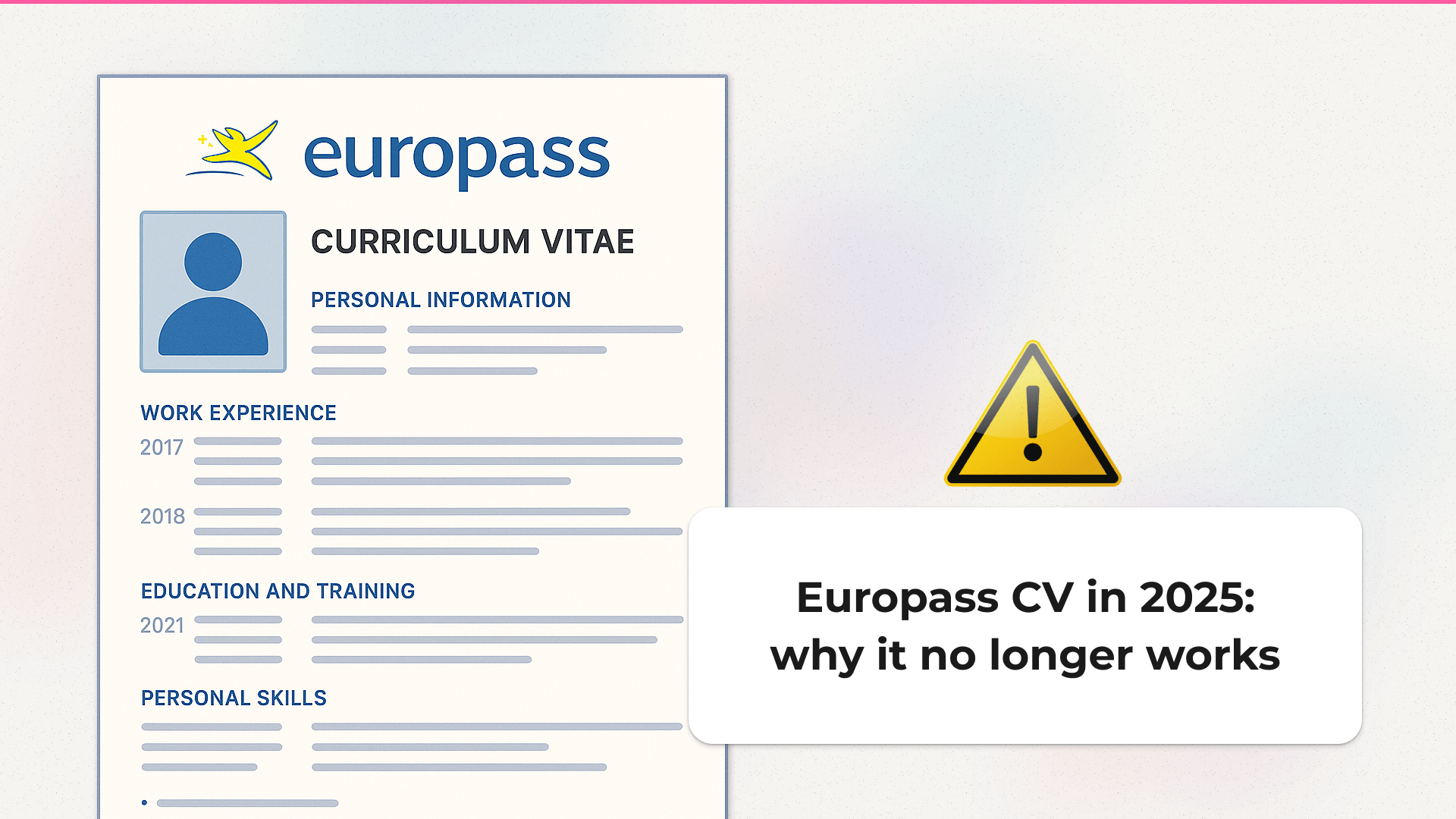
Europass CV in 2025: why it's no longer a smart choice for job hunting
